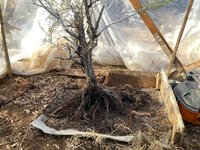GreatBasinBonsai
Seedling
I have been obsessed with collecting Curlleaf mountain mahogany (cercocarpus ledifolius) for about 15 years, and I am starting to have some success but there is a missing piece of the puzzle I would love to dial in. They are nitrogen fixing trees and I have heard/read that they require less/little/no nitrogen, but I'm not sure if I'm giving them a proper fertilizing regimen.
They are in pumice, sometimes with a mixture of decomposing pine bark and/or lava and/or spagnum.
I have been using @Brian Van Fleet 's diy fertilizer cakes (thanks and shout out to him ) along with a supplemental variety of kelp, humic/fulvic acids, and root Mycorrhizal drenches. And sparingly on the fertilizer. So basically I AM supplying some nitrogen, in an organic form, with the idea that if they don't actually need it, it will hopefully at least not come in a form that hurts them.
) along with a supplemental variety of kelp, humic/fulvic acids, and root Mycorrhizal drenches. And sparingly on the fertilizer. So basically I AM supplying some nitrogen, in an organic form, with the idea that if they don't actually need it, it will hopefully at least not come in a form that hurts them.
It is also my understanding that perhaps it is nitrifying organisms that are doing the actual nitrogen fixing and not the root tissue itself. So maybe if the bacteria etc aren't using the nitrogen that I am dumping on them, it will just wash away with whatever other nutrients are not needed.
Does this sound like a solid plan? What would you suggest?
I would love to hear from someone who has real scientific information/knowledge/experience, not just conjecture. I have read what little available literature and published papers on the subject I can find, but can't get a real solid answer.
I should mention that the trees I have had the longest are about five years post collection, and although they suffered some branch die back early on (see photo taken this spring during a repot and light field soil removal) they seem to slowly be regaining vigor but i just want to make sure I'm giving them the very best shot at long-term survival, and eventually making the transition into an actual Bonsai Pot, which will probably be at least a 10 year process.
Thanks thanks!

They are in pumice, sometimes with a mixture of decomposing pine bark and/or lava and/or spagnum.
I have been using @Brian Van Fleet 's diy fertilizer cakes (thanks and shout out to him
It is also my understanding that perhaps it is nitrifying organisms that are doing the actual nitrogen fixing and not the root tissue itself. So maybe if the bacteria etc aren't using the nitrogen that I am dumping on them, it will just wash away with whatever other nutrients are not needed.
Does this sound like a solid plan? What would you suggest?
I would love to hear from someone who has real scientific information/knowledge/experience, not just conjecture. I have read what little available literature and published papers on the subject I can find, but can't get a real solid answer.
I should mention that the trees I have had the longest are about five years post collection, and although they suffered some branch die back early on (see photo taken this spring during a repot and light field soil removal) they seem to slowly be regaining vigor but i just want to make sure I'm giving them the very best shot at long-term survival, and eventually making the transition into an actual Bonsai Pot, which will probably be at least a 10 year process.
Thanks thanks!

Last edited:

